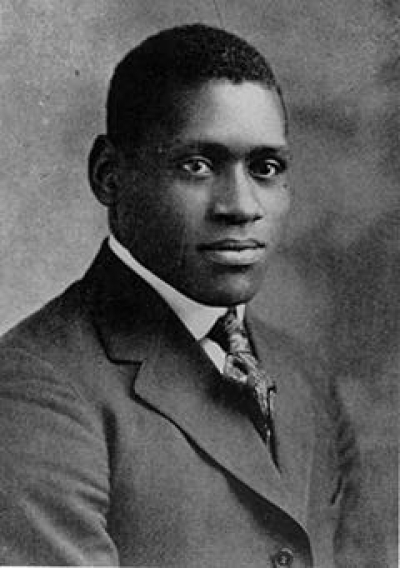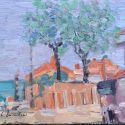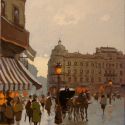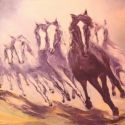
Biography
The neutrality and factual accuracy of this article are disputed.
Please see the relevant discussion on the talk page.
USPS Black Heritage stamp
Paul Robeson (April 9, 1898 – January 23, 1976) was a multi-lingual American actor, athlete, bass-baritone concert singer, writer, and radical civil rights activist.
Contents
1 Birth and siblings
2 Education
2.1 Rutgers
2.2 Columbia Law School
3 Marriage and children
4 Actor and singer
4.1 Activism and advocacy
4.2 Robeson and the Soviet Union
4.3 International Travel Ban
4.4 Wales
5 Later life
6 Legacy
7 Quotes
8 Source Notes
9 Biographies of Paul Robeson (incomplete list)
10 Periodical References
11 Other References
12 External links
12.1 Archives
12.2 Articles
12.3 Other
Birth and siblings
Robeson was born in Princeton, New Jersey. His father William Drew Robeson I(1845-1918) ran away from a North Carolina plantation where he had been enslaved; he later graduated from Lincoln University, and became a church minister.[1] His mother, Maria Louisa Bustill came from an abolitionist Quaker family .[2] Paul's four siblings include: William Drew Robeson, a physician who practiced in Washington, DC; Benjamin Robeson, a minister; Reeve Robeson (called Reed), and Marian Robeson, who lived in Philadelphia, Pennsylvania. In 1915, he graduated with honors from Somerville, New Jersey High School where he excelled academically, and participated in singing, acting, and athletics.
Education
Rutgers
Robeson won an academic scholarship to Rutgers University. Robeson and his father had wanted him to attend Princeton University, but Princeton did not admit blacks at the time. He is usually considered to be only the third African-American accepted at Rutgers, although there is reason to believe there were more than two before him. Robeson was one of only three classmates at Rutgers accepted into Phi Beta Kappa. He was valedictorian of his graduating class and was one of only four students selected in 1919 to Cap and Skull, the honor society at Rutgers[3]. Robeson was also a noted collegiate athlete. He earned fifteen varsity letters in football, baseball, basketball, and track and field. For his accomplishments as an end in football, he was twice named a first-team All-American (1917 and 1918). Football coach Walter Camp described him as "the greatest to ever trot the gridiron." [4] After he gained infamy for his Communist ties, his name was struck from the roster of the 1917 and 1918 college All-America football teams. [September 26, 1982, The New York Times]
Columbia Law School
After graduation, Robeson moved to Harlem and earned a law degree at Columbia, graduating in the same law school class as United States Supreme Court Justice William O. Douglas. Between 1920 and 1923, Robeson helped pay his way through law school by working as an athlete and a performer. He played professional football in the American Professional Football League, served as assistant football coach at Lincoln University in Pennsylvania and starred in the 1922 play Taboo in New York and in London.[5] At Columbia, Robeson joined Alpha Phi Alpha Fraternity, the oldest intercollegiate Greek-letter fraternity for African Americans. He graduated in 1923 and was hired at the law firm of Stotesbury and Miner in New York City but quit after a white secretary refused to take dictation from him because of the color of his skin. Robeson later studied at the School of Oriental and African Studies at the University of London.
Marriage and children
He married Eslande(Essie) Cardozo Goode (1896-1965) in August of 1921. She headed the pathology laboratory at Columbia Presbyterian Medical Center in New York City. Cardozo Goode was related to the U.S. Supreme Court Justice Benjamin Cardozo. Robeson and his wife had one child: Paul Robeson II, born in 1927.
Actor and singer
Paul Robeson by Yousuf Karsh, 1938.
Robeson found fame as an actor and singer with his fine baritone voice. In addition to his stage performances, his renditions of old Negro spirituals were acclaimed. His first roles were in 1922 playing Simon in Simon the Cyrenian at the Harlem YMCA and Jim in Taboo at the Sam Harris Theater in Harlem. Taboo was later re-named Vodoo. He was acclaimed for his 1924 performance in the title role of Eugene O'Neill's The Emperor Jones - originally performed, also with great success, by Charles Gilpin in 1920. Next he played Crown in the stage version of DuBose Heyward's novel "Porgy", which provided the basis for Gershwin's opera "Porgy and Bess", and, in 1930, he played Othello in England, when no US company would employ him for the role. He reprised the role in New York in 1943-1945. At the time, the Broadway run of Othello was the longest of any Shakespeare play. He won the Spingarn Medal in 1945 for this performance. Uta Hagen played Desdemona, and José Ferrer played Iago. Robeson's repertoire of African-American folk songs helped bring these to much wider attention both inside the US and abroad — in particular his rendition of "Go Down Moses". Robeson also became interested in the folk music of the world; he came to be conversant with 20 languages, fluent or near fluent in 12. His standard reportoire after the 1920s included songs in many languages (e.g., Chinese, Russian, Yiddish, German, etc.).
Between 1925 and 1942 Robeson appeared in eleven films - all but four of them British productions - after he and his wife moved to England in the late 1920s. He remained there, with long periods away on singing tours, until the outbreak of World War II. At the height of his popularity in the 1930s, Robeson became a major box office attraction in British films such as Song of Freedom and The Proud Valley. Briefly returning to the US he reprised his title role in the film version of The Emperor Jones in 1933. He was also cast as Joe in the 1936 film version of Show Boat. His performance of "Ol' Man River" for this film was particularly notable. He was Umbopa in the 1937 version of King Solomon's Mines. In films such as "Jericho" and "Proud Valley," he portrayed strong black American male leading roles.
Activism and advocacy
Stamp issued by East Germany in 1983 to honor Paul Robeson.
Robeson was among the first performers to sing in concert on behalf of the U.S. World War II war effort.[September 26, 1982, The New York Times]
He sang and spoke out against racist conditions experienced by Asian and Black Americans; he condemned segregation in both the North and the South. In particular, Robeson spoke out against lynching and, in 1946, he founded the American Crusade Against Lynching.
Robeson and the Soviet Union
Like many intellectuals and artists of the time, Robeson supported the Soviet Union. On July 8, 1943, at the largest pro-Soviet rally ever held in the United States, an event organized by the Jewish Anti-Fascist Committee and chaired by Albert Einstein, Robeson met Solomon Mikhoels, the popular actor and director of the Moscow State Jewish Theater and the Yiddish poet Itzik Feffer. Mikhoels headed the Jewish Anti-Fascist Committee in what was then the Soviet Union; Feffer was his second. After the rally, Robeson and his wife Essie entertained Feffer and Mikhoels.[6]
Six years later, in June 1949 during the 150th anniversary celebration of the birth of Alexander Pushkin, Robeson visited the Soviet Union to sing in concert. He was given a warm public welcome. [7]
But Robeson was troubled because the Jewish pianist who had accompanied Robeson's concerts was denied a visa by the Russians, and their closest Russian Jewish friends were conspicuous by their absence. Concerned about their welfare, Robeson demanded of his Soviet hosts that he see Feffer. When they met, an obviously tortured Feffer indicated that Mikhoels had died in a suspicious motor vehicle accident. Unbeknownst to Robeson, Feffer -- who had been working as a Soviet agent -- might have set up the execution of Mikhoels himself. Not knowing of Feffer's role in Mikhoels' state-sponsored murder, Robeson paid tribute to both Feffer and Mikhoels during his concert in Tchaikovsky Hall, June 14, 1948. After a short speech, he sang in tribute, the Warsaw Ghetto Uprising song "Zog Nit Kaynmal" in both Russian and Yiddish in defiance of Soviet authorities[8] and in solidarity with artists and writers who were then being persecuted by Stalin. [9], [10]
However hard he worked behind the scenes, Robeson refused to criticize the USSR in public.[11]
In 1952, Robeson was awarded the Stalin Peace Prize. Robeson wrote a tribute in April, 1953 shortly after Joseph Stalin's death entitled To You Beloved Comrade, in which he praised Stalin's "deep humanity", "wise understanding", "monumental heritage", and Stalin's dedication to peaceful co-existence with all mankind [12].
International Travel Ban
In 1950, after he refused to sign an affidavit swearing that he was not a Communist [13] the U.S. government took away Robeson's passport and, with it, his freedom to travel outside the United States. When Robeson and his lawyers met with officials at the U.S. state department August 23, 1950 and asked why it was "detrimental to the interests of the United States Government" for him to travel abroad, "they were told that his frequent criticism of the treatment of blacks in the United States should not be aired in foreign countries—it was a "family affair." (Duberman, p. 389)
In the travel ban, Robeson joined other radicals whose right to travel was prohibited, including the writers Howard Fast and Albert Kahn, and Richard Morford who headed the National Council of America-Soviet Friendship. In his detailed biography of Robeson, Duberman sought and received answers to his requests under the freedom of information law. One such answer came in the state department's 'memorandum for file' summarizing the August 23, 1950 meeting between U.S. officials and Robeson and his attorneys. (Duberman, p. 389, 411). The internal state department memorandum reveals that U.S. government officials asked Robeson to sign a statement guaranteeing not to give any speeches while outside the U.S.. When Robeson refused, the State Department declined to reconsider his passport application. His attorneys protested that this amounted to an unconstitutional violation of the right of free speech.(Duberman, p. 389)
While no U.S. citizen needed a passport to travel to and from Canada, the State Department also took steps to prevent Robeson from leaving the U.S. to sing at a concert in Vancouver, British Columbia in January 1952. Falling back on legislation passed during World War I "during the existence of a national emergency"—to prevent the entry or departure of its citizens, U.S. officials stopped Robeson from singing in Canada.
In an act of defiance against the travel ban, labor unions in the U.S. and Canada organized a concert at the International Peace Arch on the border between Washington State and the Canadian Province of British Columbia on May 18, 1952. (Duberman, p. 400) Paul Robeson stood on the back of a flat bed truck on the American side of the U.S.-Canada border and performed a concert for a crowd on the Canadian side, variously estimated at between 20,000 and 40,000 people. Robeson returned to perform a second concert at the Peace Arch in 1953. (Duberman p. 411)
The travel ban ended in 1958 when Robeson’s passport was returned to him after the U.S. Supreme Court ruled that the Secretary of State had no right to deny a passport or require any citizen to sign an affidavit because of his political beliefs.(Duberman, p. 463)
Wales
Robeson's association with Wales began in 1928 while he was performing in London in the musical Show Boat. There, he met a group of unemployed miners who had taken part in a "hunger march" from South Wales to protest their situation. During the 1930s, Robeson made several visits to Welsh mining areas, including performances in Cardiff, Neath and Abadare.[14] In 1934, he performed in Caernarvon to benefit the victims of an industrial accident at Gresford colliery, near Wrexham, in which 264 miners were killed.[15] In 1938, he performed in front of an audience of 7,000 at the Welsh International Brigades National Memorial in Mountain Ash, to commemorate the 33 men from Wales killed while fighting on the side of the Republic in the Spanish Civil War. In 1940, he appeared in The Proud Valley, playing a black laborer who arrives in the Rhondda and wins the hearts of the local population.
Between 1952 and 1957, Robeson was invited to sing at the Miners' Eisteddfod, an arts festival, in Porthcawl. He was unable to attend because the United States government had confiscated his passport and banned him from traveling. In 1957, he spoke and sang to the Eisteddfod over a secretly-arranged transatlantic telephone link, beginning with a greeting to those in attendance: "My warmest greetings to the people of my beloved Wales, and a special hello to the miners of South Wales at this great festival. It is a great privilege to be participating in this historic festival. All the best to you as we strive toward a world where we all can live abundant, peaceful and dignified lives."[16]
Welsh miners' organisations were among the most prominent international supporters of the campaign calling for the restoration of his passport and to Let Paul Robeson Sing!. When his passport was returned in 1958 as a result of a United States Supreme Court decision in a related case, Robeson traveled to Wales as a guest of the MP Aneurin Bevan to appear at the National Eisteddfod in Ebbw Vale. He then performed at the Miners' Eisteddfod, fulfilling a promise he had made while prevented from traveling. In 1960, Robeson's final performance at the Royal Festival Hall in London included choral accompaniment from the Cwmbach Welsh male voice choir.[17]
Robeson remains a celebrated figure in Wales. The exhibit Let Paul Robeson Sing! was unveiled in Cardiff in 2001, going on to tour several Welsh towns and cities.[18] A number of Welsh artists have celebrated Robeson's life: The Manic Street Preachers' song "Let Robeson Sing" appears on the album Know Your Enemy. The band also covered "Didn't My Lord Deliver Daniel?"— the spiritual sung by Robeson as part of his 1957 telephone performance. The play Paul Robeson Knew My Father by Greg Cullen, set in the Rhondda during the 1950s, features a character with a childhood obsession for Robeson's music and films.[19]
Later life
This article or section contains information that has not been verified and thus might not be reliable. If you are familiar with the subject matter, please check for inaccuracies and modify as needed, citing sources.
He moved to the United Kingdom. He spent five years touring the world, playing Othello again in Tony Richardson's 1959 production at Stratford-upon-Avon, singing throughout Europe as well as Australia and New Zealand. It was on his visit to England that he befriended actor Andrew Faulds and inspired him to take up a career in politics. [citation needed] Robeson's health began to break down and he spent some time in Russian and East German hospitals.
In 1961, Robeson attempted suicide in a Moscow hotel room. His son claimed[20] this was preciptated by a CIA agent who placed some synthetic hallucinogens into his drink under a covert program called MK Ultra. Paul Robeson returned to live in the United States in 1963. For the remainder of his life he was plagued by ill health, and his appearances were relatively few. His 75th birthday was celebrated in Carnegie Hall, where his taped message was played. [citation needed]
In 1976, at the age of 77, Paul Robeson died in Philadelphia, Pennsylvania, where he had been living with his sister. He was interred in the Ferncliff Cemetery in Hartsdale, New York.
Legacy
This article or section contains information that has not been verified and thus might not be reliable. If you are familiar with the subject matter, please check for inaccuracies and modify as needed, citing sources.
Robeson sang in and was conversant in more than 20 languages, and at one time carried enough clout to be considered for a vice presidential spot on Henry A. Wallace's 1948 Progressive Party ticket. [citation needed]
He co-founded the Progressive Party and the Council on African Affairs. [citation needed]
He won numerous awards from such organziations as the U.S. Treasury Dept. (War Bonds), the NAACP (Springarn Medal), Broadway (Donaldson award; equivalent to the Tony today) [citation needed]
He was the first African-American to demand and receive the right to final approval of films (though only effectively in three films), and portrayed strong black male American roles 15 years before Sidney Poitier (albeit mostly in British films) [citation needed]
He is considered to be one of the greatest college football players of all time [citation needed] (two-time All-American), and won 15 varsity letters at Rutgers.
Led anti-lynching delegation to Pres. Truman, and another delegation to lift the ban on black players in major league baseball. [citation needed]
First to bring Negro spirituals to the concert stage. [citation needed]
His 1940s Othello was eventually seen by over half a million viewers on Broadway or on tour. [citation needed]
Hailed by Langston Hughes as the "truly racial voice" ("Negro Artist and the Racial Mountain," 1926)
After the CBS "Ballad For Americans" broadcast in 1939 (longest applause ever on live radio) [citation needed], became known as a symbol for America. [citation needed]
Numerous schools, community centers and theaters across the United States have been named for him. [citation needed]
The main student union at Penn State University is the HUB-Robeson Center; it contains the Paul Robeson Cultural Center.
Three buildings on the Rutgers University campus are named in his honor.
The Paul Robeson House in West Philadelphia, where he lived with his sister at the end of his life, is a museum.
In 1978, the United Nations honored Robeson for speaking out against apartheid in South Africa. [citation needed]
In 1983, the East German government honored him with a postage stamp.
In 1988, he was posthumously inducted into the Rutgers University sports Hall of Fame.
In 1995, he was inducted into the College Football Hall of Fame.
In 1998, he received a Grammy Award for Lifetime Achievement.
In 2001, the Welsh rock group Manic Street Preachers remembered Robeson in their song tribute "Let Robeson Sing".
In 2003, the National Library of Wales in Aberystwyth featured Robeson's life story in a special exhibit focusing on his love for the working people of Wales. [citation needed]
In 2004, the United States Postal Service honored Robeson with a stamp in the Black Heritage Series.
Quotes
If the United States and the United Nations truly want peace and security let them fulfill the hopes of the common people everywhere -- let them work together to accomplish on a worldwide scale, precisely the kind of democratic association of free people which characterizes the Soviet Union today. - Daily Worker; November 15, 1945
Because my father was a slave, and my people died to build this country, and I am going to stay here and have a part of it just like you. And no Fascist-minded people will drive me from it. Is that clear?. . .I am here because I am opposing the neo-Fascist cause which I see arising in these committees. You're the Alien and Sedition Act, and Jefferson could be sitting here, and Frederick Douglass could be sitting here. . . (Philip S. Foner, ed., _Paul Robeson Speaks_ [1978/2002], p. 427)Philip S. Foner, ed., _Paul Robeson Speaks_ [1978/2002], p. 427)
I have done the state some service, and they know’t. No more of that. I pray you, in your letters,
When you shall these unlucky deeds relate,
Speak of me as I am. Nothing extenuate,
Nor set down aught in malice. . .
from Shakespeare's Othello, the final monologue which Paul Robeson frequently performed
Source Notes
^ Duberman, pg. 352-354.
^ Foner, pg. 427.
^ Stewart, pg. 225.
^ Paul Robeson Centennial Celebration, A Brief Biography
Biographies of Paul Robeson (incomplete list)
Boyle, Sheila Tully, and Andrew Bunie, Paul Robeson: The Years of Promise and Achievement ISBN
Du Bois, Shirley Graham, Paul Robeson, Citizen of the World. (Julian Messner, June 1, 1971) ISBN 0671324640; (Greenwood Pub Group, January 1, 1972) ISBN 0865434689; (Africa World Pr, January 1, 1998), ISBN 0865434697; (Africa World Pr, April 1, 1998), ISBN 0837160553
Duberman, Martin. Paul Robeson: A Biography. 804 pages. New Press; Reissue edition (May 1, 1995). ISBN 156584288X.
Dorinson, Joseph and William Pencak with foreword by Henry Foner. Paul Robeson: Essays on His Life and Legacy (Oct 15, 2004) ISBN 0786411538;
Foner, Philip S. Paul Robeson Speaks: Writings, Speeches, and Interviews, a Centennial Celebration. Citadel Press; Reprint edition (September 1, 1982). 644 pages. ISBN 0806508159.
Holmes, Burnham, Paul Robeson: A Voice of Struggle (Heinemann Library, September 1, 1994) ISBN 0811423816
Larsen, Rebecca. Paul Robeson: Hero Before His Time (Franklin Watts, September 1, 1989), ISBN 0531107795
McKissack, Pat, Fredrick McKissack and Michael David Biegel (illustrator). Paul Robeson: A Voice to Remember. Library (Enslow Pub Inc, May 1, 2001), ISBN 0894903101
Nazel, Joseph. Paul Robeson: Biography of a Proud Man. (Holloway House Pub Co, August 1, 1980), ISBN 0870676520
Robeson, Paul. Here I Stand. Beacon Press (1958), (1971 edition with Preface by Lloyd L. Brown), (January 1, 1998). 160 pages. ISBN 0807064459.
Robeson, Paul. Here I Stand. DVD. Director: St. Claire Bourne. Winstar Home Entertainment. DVD. (August 24, 1999). Run Time: 117 minutes.
Robeson Jr., Paul. The Undiscovered Paul Robeson , An Artist's Journey, 1898-1939.
Reiner, Carl, How Paul Robeson Saved My Life and Other Mostly Happy Stories (Cliff Street Books, October 1, 1999), Cassette/Spoken Word (Dove Entertainment Inc, October 1, 1999). ISBN 0060194510
Stewart, Jeffrey C. (editor); Paul Robeson Cultural Center; Jane Voorhees Zimmerli Art Museum (corporate author). Paul Robeson: Artist and Citizen. Hardcover (Rutgers Univ Pr, April 1, 1998) ISBN 0813525101, Paperback (Rutgers Univ Pr, April 1, 1998) ISBN 081352511X
Stuckey, Sterling, I Want to Be African: Paul Robeson and the Ends of Nationalist Theory and Practice, 1919-1945 (Univ of California Center for Afro, June 1, 1976) ISBN 0934934150
Wright, David K., Paul Robeson: Actor, Singer, Political Activist (Enslow Pub Inc, September 1, 1998) ISBN 0894909444
Periodical References
Robeson Jr., Paul. "How My Father Last Met Itzik Feffer." Jewish Currents. November 1981.
Whitman, Alden. "Paul Robeson Dead at 77". New York Times. Page 57, Column 2. January 24, 1976.
Other References
Radosh, Robert. The Rosenberg File: Second Edition Yale University Press; 2nd Reprint edition (February 27, 1997) ISBN 0300072058
Rappaport, Louis. Stalin's War Against the Jews: The Doctors Plot & The Soviet Solution, Free Press (October 1, 1990) ISBN 0029258219

































